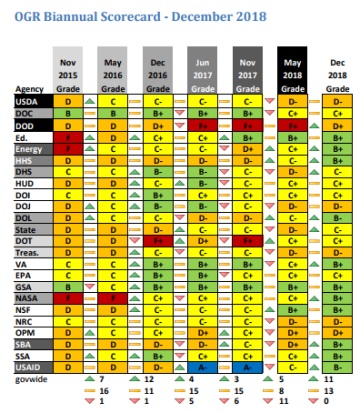Lawmakers Applaud Improved FITARA Scores, But Urge More Progress
Federal technology leaders are making progress on modernizing their information technology systems, according to the latest FITARA scorecard released Dec. 11. Lawmakers on the House Oversight and Government Reform Committee commended agencies for the improvements, but raised concerns that they aren’t taking advantage of new ways to fund the enhancements.
The subcommittees on Information Technology and Government Operations jointly released a scorecard Dec. 11 outlining agencies’ progress in meeting requirements detailed in the 2015 Federal Information Technology Acquisition Reform Act, or FITARA (PL 113-291). They found that more than half of the 24 agencies evaluated had improved their scores – graded on an A through F scale – since May 2018. For the first time since FITARA was enacted, no agencies saw their score decline from the previous scorecard, issued in May.
No agency received an overall “A” rating, but several raised theirs to a “B+,” including the departments of Health and Human Services, Energy, and Veterans Affairs, and NASA. The Defense Department got a “D+” after receiving failing grades on its last three scorecards.

In a Dec. 12 hearing, Information Technology subcommittee chairman Rep. Will Hurd(R-Texas) applauded HHS specifically for its “‘A’ by May” initiative to strengthen its FITARA score — a “D-” as recently as November 2017.
The intent of the FITARA scorecards, Hurd said, “is not to paint agencies with a scarlet letter,” but instead “to incentive behaviors and actions that result in better managed and more secure IT resources.”
“There are lessons that can be learned for what y’all have done — what HHS has done — for others to examine and pursue,” he said.
The committee graded agencies on a number of governmentwide priorities, such as adopting incremental development techniques, consolidating data centers, reducing duplicative IT investments, enhancing risk transparency, licensing software, elevating the status of agency chief information officers, and establishing working capital funds for IT.
PUTTING WORKING CAPITAL FUNDS TO WORK
Some lawmakers expressed concerns that agencies aren’t doing enough to reinvest savings toward future modernization projects through the use of IT working capital funds authorized under the 2017 Modernizing Government Technology (MGT) Act (PL 115-91).
According to the scorecard, only four agencies have plans to establish an MGT working capital fund. Fifteen agencies reported having department-wide funds that they could use for investments in technology. However the IT-related savings deposited into the funds could also be reallocated toward facilities management, personnel, or other expenses.
During the hearing, Hurd briefly grilled Health and Human Services Department deputy chief financial officer Sheila Conley over her agency’s decision not to set up a separate fund solely for IT projects and overseen by HHS’s chief information officer.
Conley responded that HHS, like several other agencies, has interpreted the MGT Act as giving it statutory authority to establish an IT working capital fund, but not “explicit transfer authority” to starting moving resources into it. In other words, agencies believe the MGT Act allows them to set up a checking account, but not to start depositing or writing checks.
“It is frustrating that agencies claim they lack the transfer authority when we just passed legislation to do that,” Hurd said.
Based on Conley’s testimony, Rep. Darrell Issa (R-Calif.) recommended that the committee write to the Office of Management and Budget clarifying that it was Congress’s intent that the MGT Act give all agencies the ability to use working capital funds for IT modernization. But as Government Accountability Office principal IT researcher Carol C. Harris cautioned, the issue could be that agency leadership remains reluctant to cede control over sizeable portions of their budgets to the CIO.
“I think cultural change is really difficult,” she said. “So I think in large part, one of the reasons why agencies are not quick to embrace this MGT is a cultural issue versus a legal one.”
THE MEGABYTE BUMP
According to the scorecard, agencies’ progress in complying with the 2016 Making Electronic Government Accountable By Yielding Tangible Efficiencies Act, better known as MEGABYTE (PL 114-210) accounted for much of their improvement in scores.
Under MEGABYTE, the Office of Management and Budget directed each agency to “establish a comprehensive, regularly updated inventory of software licenses.” That way, agencies can track the usage of different software products to avoid overpaying or duplicating purchases.
As of December 2018, 18 out of 24 agencies had built software inventories and started using them to make investment decisions, receiving an “A” grade. Each of the six remaining agencies reported that efforts were underway to complete one. As recently as May 2018, 14 of 24 agencies had received failing grades.
According to GAO’s Harris, the consolidation of software licenses is expected to save $714 million governmentwide in fiscal 2018 alone – a figure seven times the amount Congress appropriated for the governmentwide Technology Modernization Fund, established in December 2017.
Chris Cornillie is a federal market analyst with Bloomberg Government.
To contact the analyst: Chris Cornillie in Washington at ccornillie@bgov.com
To contact the editors responsible for this story: Daniel Snyder at dsnyder@bgov.com; Jodie Morris at jmorris@bgov.com